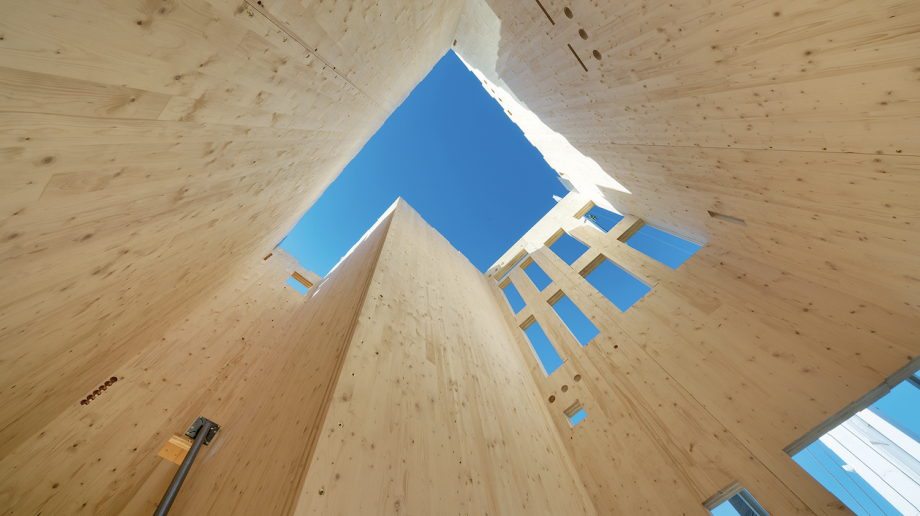
Building for the future with timber
With the government’s school rebuilding programme in progress, Andrew Orriss from the Structural Timber Association examines how structural timber solutions can assist in this effort, especially from an environmental and wellbeing point of view
Once completed, the government’s school rebuilding programme will help to transform education for thousands of pupils across the United Kingdom. The landmark project, which aims to deliver 500 rebuilding projects over the next decade marks a significant new chapter in education infrastructure investment.
Building for the future
It is absolutely crucial that those overseeing the programme build with future demands in mind. For example, at present, the sector risks building structures, which contribute to the worsening of existing problems. Most notably: excessive and unsustainable carbon consumption.
According to the UK Green Building Council, the built environment contributes around 40 per cent of the UK’s total carbon footprint. More worryingly, the total operational and embodied carbon footprint of the built environment equates to around 22 per cent of the UK’s carbon footprint. So, when embarking on major development schemes, such as the school rebuilding programme, it is important that the sector looks for ways to improve on these figures. A clear place to start is careful consideration of the building materials specified prior to construction.
Reducing embodied carbon
Widely heralded as the most sustainable building material and totally carbon-neutral, structural timber can help developers in reducing the embodied carbon footprints of forthcoming projects, such as those on the school rebuilding programme. Likewise, the material can be sourced in a sustainable manner from carefully managed forestries.
What’s more, timber is able to sequester carbon dioxide out of the atmosphere. Over its lifecycle, timber trees consume carbon dioxide through photosynthesis. To this end, one kilogram of timber normally contains around 500 grams of carbon. Therefore, by building with timber, education facilities can help to keep this carbon trapped inside the material and mitigate its impact on the environment. As such, structural timber solutions offer an effective ‘carbon sink’ in the battle against climate change.
Improving wellbeing
Reducing embodied carbon isn’t the only area that the school rebuilding programme must focus on. As always, such developments must also prioritise building solutions that aid the wellbeing of those inside of them. Thankfully, structural timber solutions are also able to deliver on this front too, allowing buildings to be constructed with high levels of thermal efficiency. In turn, this allows schools to better regulate internal temperatures and create atmospheres that are neither too warm, or too cold to learn in.
To this end, a number of studies have highlighted the link between comfortable environments and improved learning and productivity rates. In particular, research from ‘School Without Stress’ has highlighted that pupils in timber-clad classrooms tend to be less stressed and better able to concentrate than those in alternative structures. Likewise, a number of additional studies have found that individuals who are dissatisfied with thermal comfort levels are more prone to suffer from diminished productivity rates.
Additionally, by improving thermal efficiency values, developers are also creating structures that need less energy to heat, or cool. In fact, at the STA, we have several members, including Innovaré Systems Limited who have worked on education developments, which use structural timber building solutions to reach the Passivhaus Standard. Such results can help to greatly reduce operational carbon consumption within buildings. If applied across the full range of schools scheduled to be upgraded, this benefit could therefore help to yield significant results on a national level.
Speaking on this subject, Innovaré Systems’ director, Gareth Ellison commented: “When delivered as part of an offsite manufactured system structural timber is a highly airtight and thermally efficient building material. These characteristics mean structural timber is ideally placed to deliver to the increasingly onerous requirements in building performance and net zero carbon targets.”
Building more effectively
Whilst timber as a material has been around forever, the building techniques that normally accompany it across the construction sector tend to be more modern. In particular, structural timber solutions are especially well-suited to modern methods of construction. By the same token, modern methods of construction are ideal for school rebuilding programmes where turnaround times are often very tight and highly dependent on the school’s broader calendar of events and holiday periods.
This benefit is of particular note when considered in relation to the ongoing school rebuilding programme. Given the size of the infrastructure project, the enhanced reliability of building using modern methods of construction can help to ensure projects are completed on time. What’s more, as the vast majority of work conducted under these principles happens offsite, projects become far less weather dependent. This can make a massive difference in avoiding delays and staying on budget.
Better environments for all
It’s clear that structural timber is able to deliver across a great number of fronts. For one, the building material offers the education sector a way to reduce the embodied carbon levels of its buildings. At the same time, the material is able to deliver long-term, durable structures, which are suited to the demands placed on such facilities. Finally, structural timber solutions can be sourced in a highly sustainable manner.
Once specified, structural timber solutions can help contribute to more efficient building programmes on account of their suitability to modern methods of construction. Likewise, buildings produced with the material are able to achieve exceptional thermal efficiency levels and provide highly conducive spaces for learning.
That’s why at the STA we believe structural timber is an obvious choice for those overseeing the school rebuilding programme and can no longer be overlooked by those in charge of the process. Structural timber solutions offer a number of advantages, which are particularly relevant to the scheme and can help to support the creation of a new generation of education facilities that perform better from a sustainability and wellbeing perspective.
Latest News
31/10/2025 - 10:12
A growing number of UK children are now eligible for Free School Meals (FSM), yet most still aren’t taking advantage of them on a daily basis, new research reveals.
30/10/2025 - 01:28
In the wake of the Raac crisis, the DfE spent £5 million on research into the condition of school buildings, which is due to conclude in spring 2026.
30/10/2025 - 01:09
Malmesbury Primary School in Wiltshire has submitted plans for a major expansion, funded by entrepreneur James Dyson.
30/10/2025 - 00:55
Monday's Every Pair Tells a Story campaign to protest to highlight the national crisis in SEND provision.
29/10/2025 - 09:19
Estimated data from the Department for Education reveals that 470,000 pupils under 16s use local authority funded transport to get to school.







